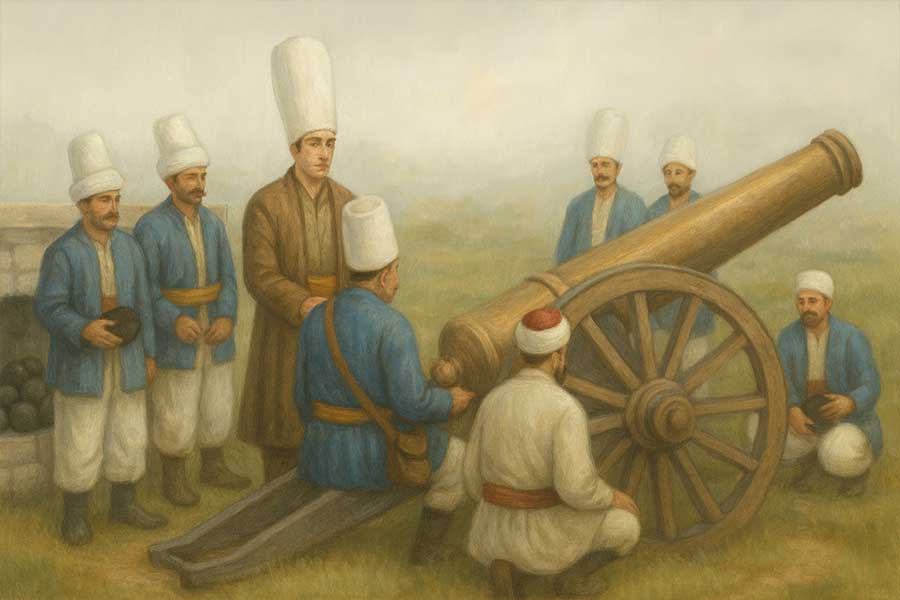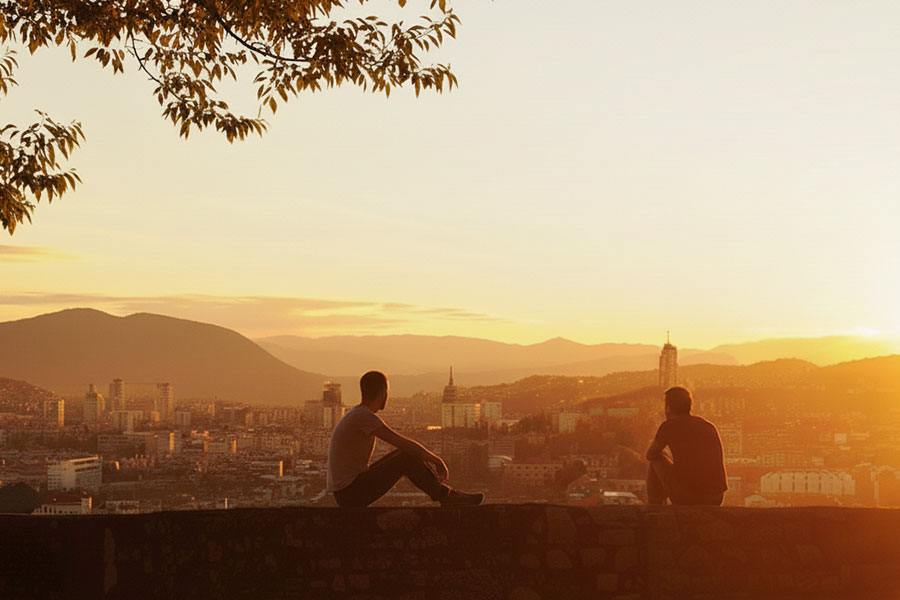On Jekovac Hill, just above the heart of Baščaršija, stands the Yellow Fortress – a stronghold that may not have the size or strength of the White Fortress, but holds a different kind of power: the ability to stop time. As the sun sets behind the mountains, the city below sinks into a sea of lights, and the Yellow Fortress becomes Sarajevo’s most beloved balcony. Tourists, locals, couples, photographers, and dreamers all gather here, sharing the same view, the same silence, and the same awe.
Table of Contents
The History of the Yellow Fortress
The Yellow Fortress was built in the 18th century, during the Ottoman period, as part of a broader effort to fortify Sarajevo. Together with the White Fortress and the large defensive walls and gates of Vratnik, the Yellow Fortress formed part of the protective ring that guarded the city.
The fortress itself was smaller and simpler than its “white sister” but equally strategic. It was constructed from stone and earth, designed primarily as a lookout and defensive point. Its location made it crucial: from here, anyone could see far across the valley, giving defenders the chance to prepare for enemy approaches.
In 1878, during the Austro-Hungarian occupation of Sarajevo, the Yellow Fortress witnessed fierce battles. Though partially damaged and later repaired, its walls still carry the memory of that turbulent time.
But the fortress was not only about war. During the Ottoman period, the Yellow Fortress gained another role: it became the place from which cannon fire announced the end of the daily fast during the holy month of Ramadan. This tradition gave the fortress a special spiritual significance – connecting the rhythms of the city with the rhythms of faith.
Who Built the Yellow Fortress?

The exact architect of the Yellow Fortress is not known. Its construction was ordered by the Ottoman military authorities in the mid-18th century as part of a larger defensive plan for Sarajevo. What makes the fortress remarkable is that, although modest in size compared to the White Fortress, it was designed to be functional and efficient.
In many ways, the Yellow Fortress represents the Ottoman philosophy of military architecture – practical, adaptable, and deeply connected to the urban life it was built to protect.
The Purpose of the Yellow Fortress

The original purpose of the Yellow Fortress was straightforward: to guard the eastern approaches to Sarajevo. Soldiers stationed here could watch for danger, fire cannons in warning, and protect the vulnerable parts of the city’s defensive wall.
But with time, the fortress became more than just a military point. Its elevated position and sweeping views gave it a symbolic role as well – a reminder that Sarajevo was watched over and protected.
In modern times, the fortress has been reimagined once again. Today, the Yellow Fortress is no longer about defense but about connection: it connects locals and visitors to the city’s beauty, to its traditions, and to each other.
Why is the Yellow Fortress Famous Today?
Today, the Yellow Fortress is famous for two things: sunsets and tradition.
- Sunsets: If you ask a local where to see the best sunset in Sarajevo, the answer will almost always be the Yellow Fortress. As the sun dips behind the mountains, the sky turns shades of orange, red, and purple, while the city below begins to glow with lights. It is one of those rare places where time seems to stop, and the view feels like a painting.
- Ramadan tradition: For centuries, a cannon has been fired from the Yellow Fortress each evening during the holy month of Ramadan, marking the end of the fast. This tradition continues today, making the fortress a deeply spiritual as well as cultural landmark.
Where is the Yellow Fortress and How to Get There
The Yellow Fortress is located on Jekovac Hill, above the old part of Sarajevo, just a short distance from Baščaršija.
Ways to reach the Yellow Fortress:
- On foot: About 10–15 minutes from Baščaršija. The walk is steep but short, taking you through the charming streets of Jekovac.
- By car or taxi: Quick and easy. Parking is usually available nearby, and it is easier than at the White Fortress.
Entrance is free, and the fortress is open all year round.
What Can You Find at the Yellow Fortress Today?
Source: Youtube channel DDQQworldview
Today, the Yellow Fortress has been transformed from a defensive stronghold into a public viewpoint. Inside its walls there are no longer barracks or military facilities. Instead, visitors will find restored walls, open platforms, benches, and wide stone terraces designed for rest and enjoyment.
In summer evenings, the fortress becomes a lively place. You’ll see young people with guitars, families with picnic baskets, photographers waiting for the perfect shot, and couples enjoying the romantic atmosphere. During Ramadan, hundreds of people gather to hear the cannon fire at sunset, sharing in a moment that blends spirituality, history, and community.
Tips for Visiting the Yellow Fortress

- Best time: Just before sunset. Arrive a little earlier to secure a good spot.
- During Ramadan: Don’t miss the traditional cannon shot – it is one of Sarajevo’s oldest living traditions.
- Bring comfortable shoes and water: Especially if you’re walking uphill.
- Go on weekdays if you want quiet: Weekends can be very busy.
- Combine with Baščaršija: Since it’s close by, you can enjoy a day in the old town and then walk up for sunset at the Yellow Fortress.
Fun Facts About the Yellow Fortress
- The tradition of firing the cannon from the Yellow Fortress has lasted for centuries and continues today.
- Though smaller than the White Fortress, the Yellow Fortress has become Sarajevo’s most iconic sunset spot.
- Many locals consider it the most romantic place in the city – countless first dates, proposals, and love stories have taken place here.
- Because of its view, it is often nicknamed “Sarajevo’s balcony.”
FAQ – Yellow Fortress Sarajevo
What is the Yellow Fortress?
The Yellow Fortress is an 18th-century Ottoman stronghold on Jekovac Hill, above Sarajevo.
Where is the Yellow Fortress located?
Above Baščaršija, in the Jekovac neighborhood, about 10–15 minutes’ walk from the city center.
How much is the entrance fee to the Yellow Fortress?
Entrance is free.
When is the best time to visit the Yellow Fortress?
At sunset, or during Ramadan when the traditional cannon is fired.
Is the Yellow Fortress open year-round?
Yes, it is open to visitors at all times.
Our Most Popular Tours To Sarajevo
We offer many tours that include a visit to Sarajevo and its most popular locations:
- Sarajevo Siege Tour & War Tunnel 1992 / 1996 (Most Popular)
- Full Day tour from Sarajevo to Međugorije & Mostar
- Full Day Tour from Sarajevo to Travnik and Jajce
- Full-Day 5 Cities Tour from Sarajevo to Herzegovina (Mostar)
- Full day Tour from Sarajevo to Dubrovnik (Kotor or Split)
- Full Day tour from Sarajevo to Belgrade
Don’t Hesitate To Say Hi!
Got any questions about our tours or the city? Don’t hesitate to contact us anytime for more info and booking.
Use the following phone number and email:

